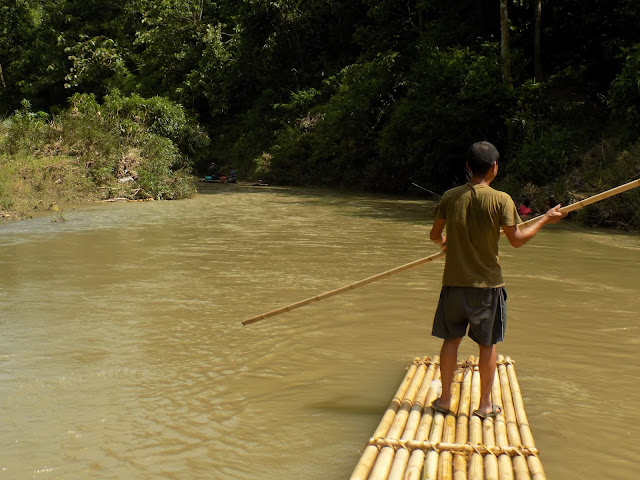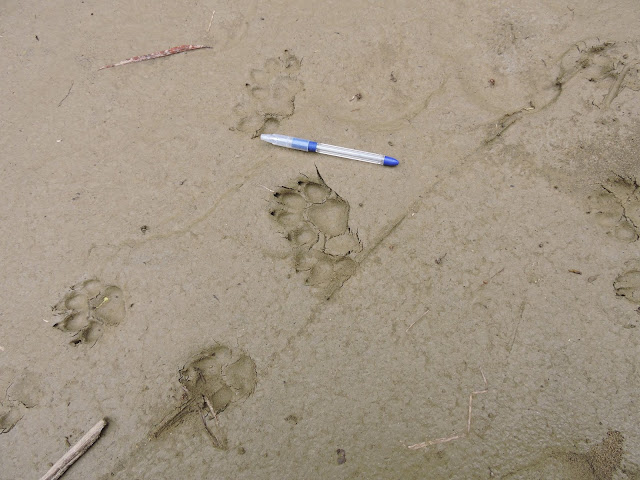A week with a bamboo raft
~ Some
glimpses of the few days of thrill ~
~ Moving
on a raft along the India – Bangladesh border ~
~ In
the Dampa Tiger Reserve ~
~ Eclectic North East publishes this post in its March 2018 issue ~
~ Eclectic North East publishes this post in its March 2018 issue ~
The
River.
So
little do we city bred know of a river! This stuck me on the first day of our
trip and would re-visit me each day of the trip. Colours where the happy
streams came down to join the river we were akin to a nature’s flowing palette;
a poetic reality! Insects came out in no small numbers when our rafts bumped
into vegetation along the banks. They, as if, checked us out and troubled no
further. The only bridge we passed under still carried the weight of the last
seasons flood. It was neither easy nor
very pleasant to imagine ourselves on the rafts with that form of the river. Within
the 60 km stretch the river’s width varied from 4 to 40 meters and it had
different sounds, sounds I could not comprehend. The water is in ripples where
it is too shallow, the person guiding the raft once said, taking cue from the silly
look on my face! Rains during the week made the Sazai river and the trip all
the more fun. On occasions they increased the water flow and on others created
stunning patterns on the flowing water. So very different from the snow-capped
tops of the Western Himalayas which appear frozen in time. Yet, no less stunning
and beautiful, as the river changed form in front of one’s eyes.
Langston
Hughes in his, The Negro speaks of rivers, writes “I’ve known rivers ancient as the world and older than the flow of human
blood in human veins. I bathed in the Euphrates when dawns were young. I built
my hut near the Congo and it lulled me to sleep. I looked upon the Nile and
raised the pyramids above it. I have known rivers: ancient, dusky rivers. My
soul has grown deep like the rivers."
Raft
and journey.
I had
had fun on wooden dug-outs on the Simsang river in Garo Hills, Meghalaya, but
this would be a first long distance on bamboo rafts. The raft consisted of 10
to 12 bamboos strung together. On these sat a few (3 to 5) perpendicular
bamboos, around they centre, their length roughly matching the raft’s breadth.
On them lay the top-most (third)
tier, little more than half the length of the lowest tier. In other words,
three layers of bamboo tied with each other, for fun on flowing water. Those in
the group, hailing from the landscape, operated and maintained these rafts with
a level of dexterity which conveyed that the bamboo and river were a way of
life, at-least for some.
During
my previous trips people had shared of bamboo getting scarce in the villages in
the Dampa
Tiger Reserve; whose western limits we were skirting as we floated. How
much do these bamboos cost, I asked, and was told around 70/- each. Where then did
the bamboo for the rafts come from I wondered? The options were not many!
We got
down at multiple locations and experienced the sludge rains had helped form. At
one of these I got stuck in knee deep mud and when finally I was able to move
realized that while I had been able to pull out my leg the foot-wear had got
stuck. To pull it out I first had to spot it! We also had long breaks to bathe
in the clear waters, especially at the junctions with Keisalam and Seling streams.
Such ‘clean’ and ‘cold’ fun these breaks were.
As we
moved along, crossing Andermanik, we stayed at anti-poaching camps and also
constructed temporary bamboo structures in the forest. This is a question that
has been raised earlier as well. Does cutting down of bamboo (for example) in such circumstances, bear
less ecological foot-print than getting tents made half way across the globe? I
am not aware to clear (read black and
white) answers but there is a need to look at our actions critically!
During
rains we took shelter under a sirpaulin (tarpaulin).
Sirpaulin was also used to protect our equipment. In Mizoram, it has multiple
purposes including that of creating mini ponds! During these rain induced halts
we not only had betel-nut but also polished off food that remained from the
last meal.
Wildlife
and fruits.
Listening
to the Hoolock
gibbon was reassuring and heart warming in the mornings. While I could not
spot the Barking deer they also made their presence audible. The sambars left
their marks at multiple locations along the river. Others in the group were
able to spot the Capped langur and Assamese macaque. On a tree, huge enough for
8 to 10 of us to stand with stretched arms to encircle, we saw bear scratch
marks. Priya Singh, the researcher who took up a camera trapping project
focusing on Clouded leopard, confirmed that the Himalayan black bear was rarer
of the 2 bear species in the Tiger Reserve, Malayan sun bear being the relatively
common species.
The
overcast skies were not ideal for birding but I spotted species which I have
not come across during my previous trips to the landscape. This stretch boasts
of possibly the lowest altitude in the Tiger Reserve and this could be the
reason for the addition to the bird-list.
The Red jungle fowl we saw as it scampered inside the forest, a burning red
against the washed green, while the Crested serpent eagle was least bothered by
our rafts. The White browed piculet stood still for a while allowing us to
partake its beauty. As the rafts floated I saw kingfishers and parakeets in
numbers I would not have imaged for Dampa.
We
also came across a teak plantation and I wondered why those trees were put up
in the first place. Poor cousins of their counterparts in the drier states and
poorer still to the bamboo forest that surrounded them. A stark reminder of
oxymoron that ‘growing forests’ is.
Abandoned
villages along the river had us enjoy mangoes and jackfruits in crazy
quantities. Their trees, lush with fruits, amidst the wilderness were a sight
to behold, and the taste will stay with us for long! Food otherwise was rice,
dal and potatoes which we had carried on the rafts and of course those perks of
moving in forests in Mizoram - wild banana flowers and cane! The potato sacks
also acted as our seats on the rafts.
Destination.
Sights
and sounds changed as we neared our destination Silsury; planted trees replaced
bamboo and bird songs changed. Along with Rajiv Nagar (where we began from) this too is a large village (more than 500 house-holds) and majority
of the people are Chakmas.
Not
much point and too much risk in taking this up in the rains we had been told.
But I am glad we did. The trip had been that combination of awe and fun; to
quote John O’Donohue ‘I would love to
live like a river flows, carried by the surprise of its own unfolding’.
Thanks
are due to co-travellers for bearing my ignorance of rivers and rafts, Border
Security Force, Mizoram Forest Department, Eclectic North East, Nasreen and CEP.



Comments
Post a Comment